Menu
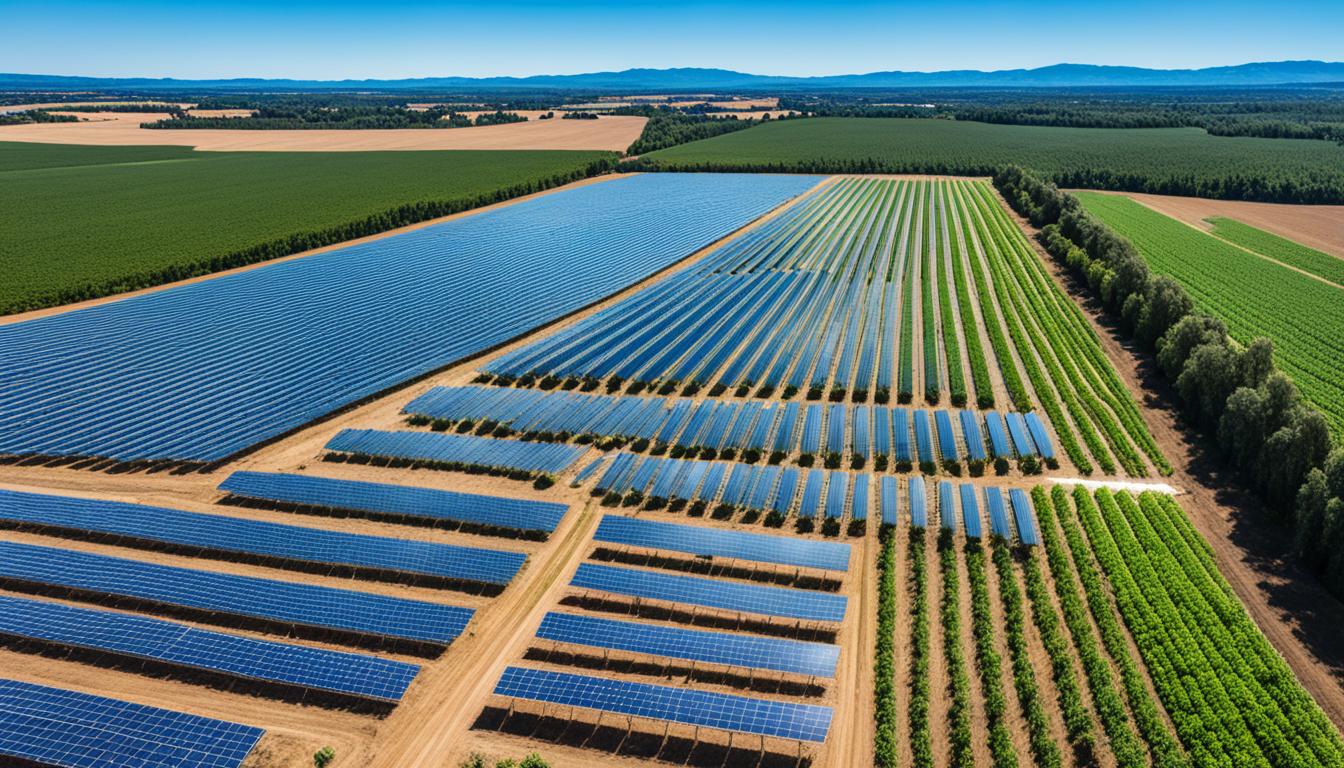
Did you know that today’s row-crop farmers harvest over six times more corn per acre than in 1940? This shows huge strides in farming methods. Yet, farming contributes 21% to 37% of global greenhouse gases. To keep the Earth’s temperature from rising too much, we need to change how we farm. The IPCC says we must limit warming to 1.5˚C.
Solutions like sustainable farming, climate-friendly techniques, and green farming lead the way. Regenerative farming and carbon-neutral practices aim to cut emissions. They also pull harmful gases out of the air. BIS Research explains that we must improve practices across all farming stages to lower emissions. Using precise irrigation and caring for the land better is key. These methods not only help the planet but also boost soil and ecosystem health.
Carbon-neutral farming is crucial in the fight against climate change. It aims to have no net carbon emissions. This work is important for sustainable food and to stop climate harm.
Farming aims to balance out the carbon it releases. The EU’s farming policies, under the CAP, support this. It’s vital because farming adds a lot to the greenhouse gas problem.
In 2018, farming caused 9.3 billion tons of carbon emissions. In Africa, farming is a big part of this. Cows, for example, make a lot of methane, which is worse than CO2. Also, meat and dairy companies are big polluters.
Now, there are efforts to make farming more eco-friendly. PepsiCo will use regenerative farming by 2030. In South Asia, they’re finding ways to reuse farm waste. These steps are key to making farming a part of the solution for climate change.
Sustainable agriculture depends on methods that don’t harm the earth, are profitable, and fair to all. A key is using farming and agriculture ways that don’t add to climate change. These practices help the land, make it safe for wildlife, and keep the soil healthy. This article will explore key principles and their positive impacts.
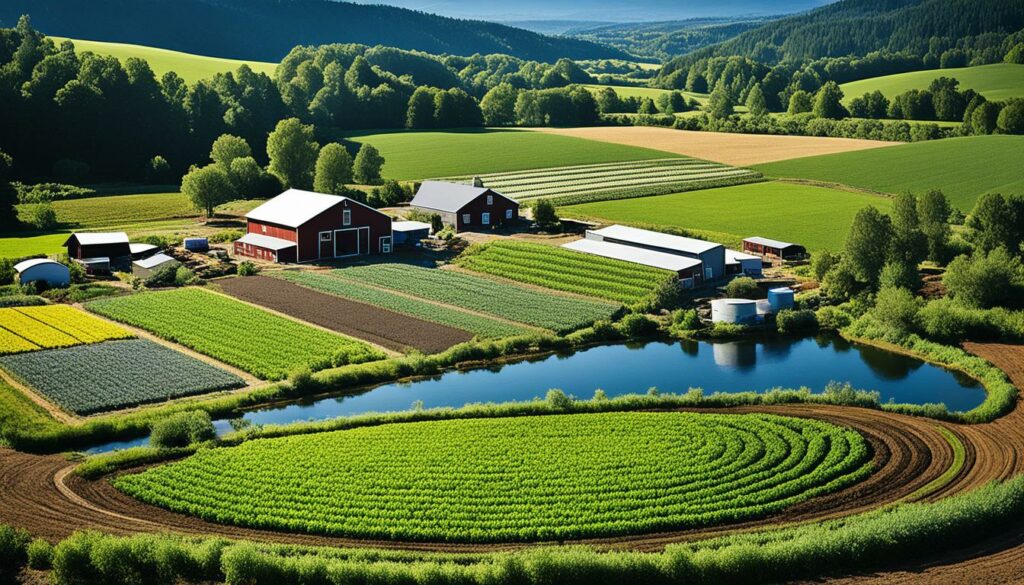
Sustainable farming relies on ways that protect our planet. Farmers avoid using harmful chemicals and aim to use resources well. They also focus on keeping the land and water safe. Methods such as changing crops often, working the soil carefully, and managing pests together help lower the impact on our environment. Water-saving methods like using water drop by drop and collecting rain help farms be efficient while being good for nature.
Choosing sustainable farming brings many good things for both the economy and society. Farming this way increases farm production and makes the soil better while stopping soil erosion. It also helps farmers find new markets for eco-friendly goods and saves money by using resources better over time. In society, it makes countryside jobs, gives people healthy foods, and builds farms that can deal with tough times.
Many fields work together in sustainable farming. Things like biology, economics, engineering, and chemistry combine to solve the big issues in growing food. This teamwork is vital for making sustainable farming work well and keep the planet and people healthy for a long future.
| Aspect | Benefit |
|---|---|
| Environmental | Reduces GHG emissions, Promotes biodiversity |
| Economic | Enhanced productivity, Long-term cost savings |
| Social | Community well-being, Job creation |
Using regenerative farming practices and organic farming for carbon neutrality offer big pluses for our world and wallets. Farmers all over have proven these ways work.
No-till farming stands out for its ability to keep soil undisturbed and trap carbon. Also, cover crops are key for soil protection. They lessen erosion and boost diversity.
Better biomass management is directly linked to storing carbon. For example, farmer Gabe Brown raised the organic carbon in his soil. He helped land “rebuild,” fighting climate change. This shows how effective these actions can be in the long run.
In Zambia, an innovative way upped the soil’s organic matter. Pig farming with mobile cages increased carbon storage significantly. This showcases how powerful regenerative farming practices are for nature.
Using drip irrigation and mixing crops can save water and boost soil and plant health. These strategies increase the variety in soil and recycle nutrients. This shift is key to organic farming for carbon neutrality.
Handling pests naturally is a big part of this work too. It helps keep the environment in balance and cuts the need for harmful chemicals.
Changing to these eco-friendly farming ways mixes old wisdom with new ideas. Those who make the switch help the planet, their farms, and might even save money.
Regenerative farming shows the wisdom of ancient farming, kept alive by Indigenous people for thousands of years. It focuses on the importance of soil in capturing carbon. This helps reduce the amount of a harmful gas, carbon dioxide, in our air.
Soil plays a key part in trapping carbon from the air, an action known as soil carbon sequestration. Bad farming has caused us to lose 133 gigatonnes of carbon around the world. But, using regenerative methods can improve this and help soils store more carbon. This could make a big difference by 2050 in tackling climate change.

Regenerative farming is much better for the earth than the usual farming methods, especially when it comes to stopping soil being washed away. Normal farming wears the soil down too fast, but regenerative agriculture helps soil health. This helps stop erosion and improves how well water soaks into the ground.
To make agriculture more sustainable, some key methods can help the soil health:
| Region | Practices | Impact |
|---|---|---|
| Africa (10 nations) | Farmer-managed natural regeneration of trees | Regenerated 24 million hectares of previously barren land |
| Central America (3 nations) | Maize-mucuna crop rotation | 25,000 farmers practising sustainable methods |
| Brazil and Paraguay | Green manure and cover cropping | Covering 25 million hectares of land, benefiting over 3 million farmers |
Beyond helping the environment, regenerative farming brings big economic and social wins. It cuts down on expensive chemical use, saving money. Plus, it creates jobs local to farms and helps rural areas grow.
Regenerative agriculture is clearly a great way forward. It boosts soil health and helps fight climate change by storing carbon. Over time, this approach will show even more environmental, economic, and social benefits.
Agroforestry is a smart way to combine trees with farming for environmental benefits. It boosts biodiversity and helps trap carbon, fitting the goal of being carbon-neutral.
Various strategies like riparian zones and windbreaks are used in places like the Northeast. They do more than one job, bringing together good for the environment, economy, and people. Plus, they help soak up a lot of the CO2 we emit, aiding in fighting climate change.
Adding practices such as windbreaks and cover crops can help farms stand strong against challenges. Even a small change can lead to a big drop in carbon in the air. Practices like silvopasture, mixing trees with pastures, can cut down on methane from animals while storing carbon.
The way you set up and look after agroforestry spaces, especially picking the right trees, plays a big part in how much carbon they hold. By bringing more benefits for production and nature, agroforestry gives farmers a clear way to help fight climate change.
Although agroforestry isn’t widely used yet because it’s hard to track and understand, people are starting to see its big promise. If agroforestry grows in the U.S., it could cut a third of the country’s yearly carbon emissions, says the USDA.
| Benefits of Agroforestry Practices | Impact |
|---|---|
| Enhances Biodiversity | Supports varied plant and animal species |
| Improves Soil Quality | Increases nutrient cycling and organic matter |
| Sequesters Carbon | Reduces atmospheric carbon dioxide |
| Provides Economic Benefits | Generates additional income streams |
| Climate Change Mitigation | Offsets greenhouse gas emissions |
To sum up, agroforestry is key to sustainable farming, with wins for the earth, people, and the economy. By blending farming with natural balance, it shows the way to a greener future.
Precision agriculture (PA) technologies can make farming better for the environment. They help farmers use resources more wisely and can move agriculture towards being carbon neutral. But, their use in the United States is still not widespread. Let’s look at the new technologies driving these changes and the improved resource use at the heart of precision agriculture.
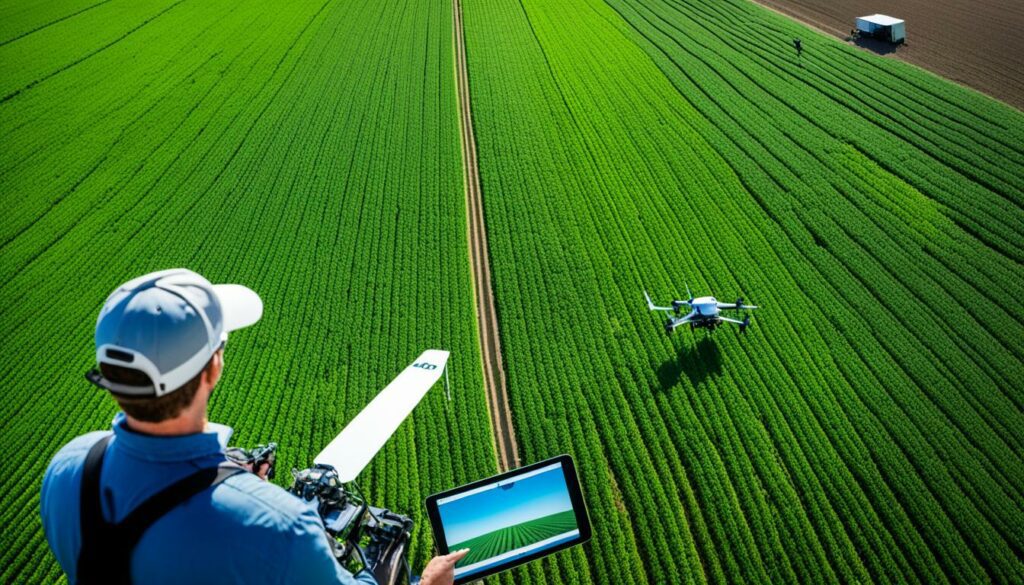
Even though precision agriculture shows a lot of potential, it faces several obstacles. These include high costs at the start, worries about keeping data safe, and not enough fast internet everywhere. To make precision agriculture more common and realise its environmental benefits, everyone needs to work together. This means governments, businesses, and farmers must all join forces.
New tools like sensors, drones, and pictures from satellites are changing how we farm. They let farmers keep a close eye on their fields and manage things better. With these new tools, farmers can use fertilisers and pesticides more carefully. They can also water their crops in smarter ways, which is good for the planet.
Using resources wisely is key in precision agriculture and in making farms carbon neutral. By looking at the soil from above and using special tools, farmers can use their water and soil better than before. This helps the soil stay healthy, stops too much CO2 from being released, and makes water use better. These things are all important for cutting down on the pollution caused by farming.
Improving in these areas, precision agriculture can help the U.S. in reaching its goal of being carbon neutral. By using high-tech methods, we can farm in ways that are good for the earth. This means we can use resources better, cut down on pollution, and farm in a way that is good for the environment.
Using renewable energy in farming is vital for eco-friendly practices. There are many choices available, each with great benefits for farms and the planet.
Solar power is easy to use in farming. Solar panels lower electricity costs and help the environment. The Investment Tax Credit (ITC) cuts taxes by up to 30%, making solar a smart financial move.
Wind power is becoming more popular, especially where the wind is constant. Wind turbines turn wind into electricity. They cost between $13,000 to $40,000 and work best with a 10 mph wind.
Bioenergy helps farmers cut emissions and use less non-renewable energy. The USDA’s Bioenergy Program supports making biofuels. This includes biofuels like biodiesel and ethanol, which are kinder to the environment than fossil fuels.
Programs like the DEP and EQIP help finance energy projects. The Increased Funding Act has also helped by improving fund and grant availability up to 50%.
Using more biomass in the U.S. could add $20 billion to farms and lower emissions. Small oil presses for biodiesel are affordable and let farmers make biofuels with crops like sunflowers.
On dairy farms, using a solar water heater can cut water heating costs by up to 85%. Monitoring financial aid programs is important for getting the most out of these options.
| Renewable Energy Source | Potential Benefits | Financial Incentives |
|---|---|---|
| Solar Power | Significantly reduces electricity bills | Investment Tax Credit (ITC) up to 30% |
| Wind Energy | Gains popularity in areas with consistent wind patterns | Wind turbines cost between $13,000 to $40,000 |
| Biofuels | Environmentally friendly alternative to fossil fuels | Rural Energy for America Program (REAP) funding up to 50% |
Organic farming is key to reducing our carbon footprint. It stops the use of synthetic pesticides and fertilisers. This cuts down on greenhouse gas emissions from agriculture. By turning 20% of California’s farmland organic by 2045, we can fight climate change strongly. The state’s move towards organic farming is big. It grew by 44% from 2014 to 2019.
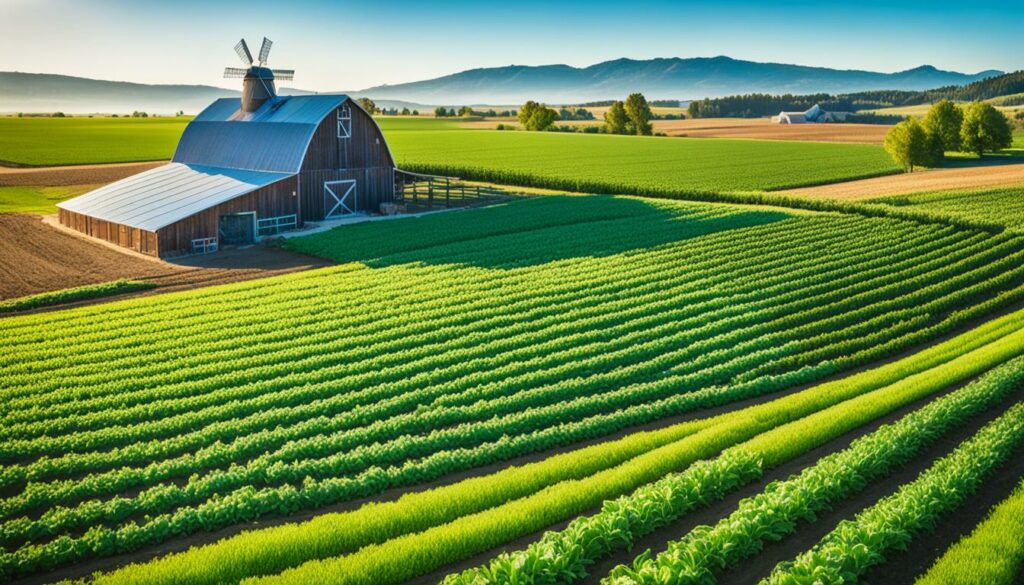
Organic farming is not just better for the planet. It also uses less energy, about 45% less. And in tough years, like droughts, organic farms still produce more, up to 40% more. This approach shows how farming can be both sustainable and strong.
By not using synthetic nitrogen, organic farms cut down on greenhouse gasses by about 20%. The soil stays healthier too. This is because without these chemicals, soil bugs and organisms that help the soil get stronger. Keeping them safe boosts the farm’s health and keeps biodiversity alive.
Some farming methods can actually take in more carbon than they give out. This makes a positive impact on the environment from now till 2100. These approaches are part of a bigger move towards lasting farming methods.
Organic dairy farms are also making big changes towards being carbon neutral. For example, Straus Family Creamery in the U.S. has a plan called the Carbon Farm Plan. This plan started in 2013. It aims to make the farm’s machines run on electric power. They also feed their cows red seaweed to cut down methane by up to 95%. This is a big step in making dairy farming less of a burden on the planet.
Trying to make farming carbon-neutral is key. Using crop rotations and cover cropping helps a lot. These methods are good for growing crops and keeping the soil healthy. They are vital for farming that lasts a long time.
Crop rotations make the soil better for growing. This means more crops and they are better at fighting off pests and diseases. Changing the types of crops stops pests from getting too used to one thing. It also makes the soil stronger. Different plants use different nutrients, helping the land stay healthy.
Rain can be a big problem in the Northeastern United States. It washes away soil and nutrients. But, planting cover crops can protect the soil. These crops also make the soil better and help stop water pollution. They even help soak up CO2 from the air. Yes, it can cost more at the start. But, in the long run, you save money. You get better crops and use less machinery.
| Benefit | Cereal Rye | Crimson Clover | Oilseed Radish |
|---|---|---|---|
| Soil Health Improvement | High | Medium | High |
| Water Pollution Reduction | High | Medium | Low |
| Weed Suppression | High | Low | Medium |
| Carbon Sequestration | High | Medium | High |
Crimson clover and cereal rye are good for the land in different ways. Choosing the right cover crops is important. It depends on where you are and how you farm. Working with experts from places like Cornell University and USDA-NRCS really helps. They know what will work best for your farm. Cover cropping is not just good for the land. It also fits with the big goal of farming in a sustainable way.
Managing livestock well is key to farming without adding to climate change. In New South Wales, Australia, livestock create about 14% of the region’s greenhouse gases. Most of this comes from the methane in their burps, with a warming effect much stronger than carbon dioxide’s.
Tackling how much methane animals make is tough but critical. It’s an issue because up to 10% of their food energy is lost this way. Ten percent of their methane comes from managing their manure. You can cut down on these gases by feeding animals better, letting them have babies earlier, and choosing which animals to keep based on how well they perform.
These steps can reduce how much methane animals make. They can also make farming more successful. Some farming methods actually remove more carbon from the air than they add. For example, Amp grazing takes away as much CO2 as two homes use power in a year.
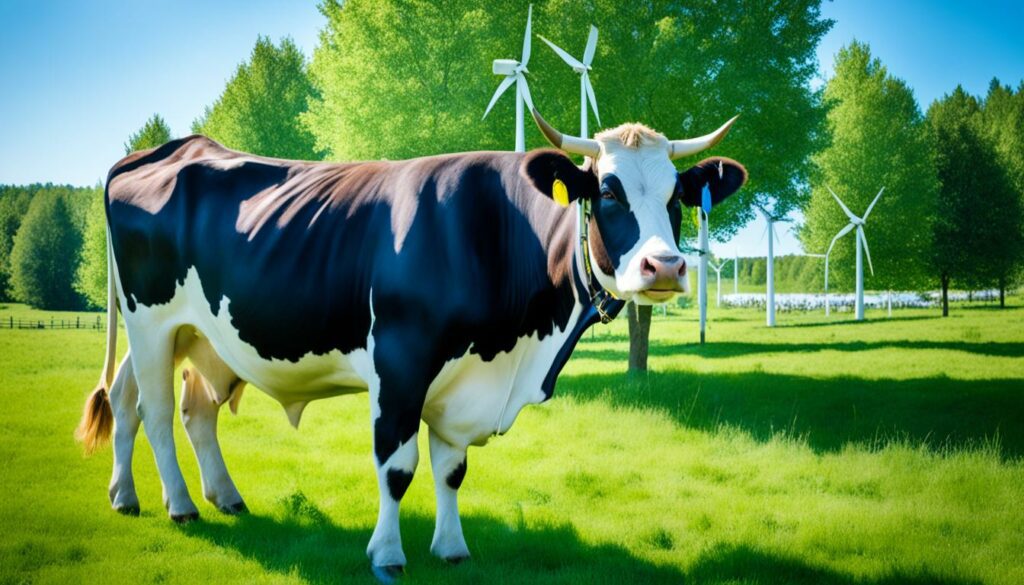
Caring for beef cows in the U.S. in a regenerative way is getting more popular. Look at Alexandre Family Farm. They’ve massively improved soil health and captured lots of carbon. This helps the earth and makes their products more valuable. The organic milk they produce sells for a lot more than usual milk, making their way of farming attractive.
More and more people are choosing to buy beef that’s been raised responsibly. They like buying straight from farms online. This change is thanks to a growing desire for clear information about where their food comes from. By using smart farming methods, the industry can be kinder to the planet and still thrive.
It’s crucial to use carbon-neutral farming practices for the future of our farms. Agriculture causes a big part of the climate crisis, with up to 37% of the gases we produce. So, moving to sustainable ways of farming is very important and it needs to happen quickly.
One key method is sustainable intensification. This has helped modern farmers grow over six times more corn on the same land since 1940. It shows we can get high yields without using more land. The IPCC experts say we could make our farms carbon-neutral by 2050, which is why improving these methods is so urgent.
Using carbon-neutral farming practices means doing lots of things differently. Like farming without turning the soil, planting cover crops, changing which crops we grow, saving water, and managing pests in natural ways. These methods don’t just reduce carbon. They also make the soil healthier, which helps farming stand up to tough times.
New technologies in farming are a big part of going green. Tractors with special tyres that press less hard on the ground and can hold more weight are a great step forward. These tyres are especially good for big tractors and help make farming more efficient and kinder to the land.
Here are some details about these tyres:
| Tyre Type | Benefits |
|---|---|
| Radial | Better grip, flexible sidewalls, enhanced road-holding, can carry more weight |
| Cross-ply | Less costly, good for front axles, not so great for heavy works |
All these steps and technologies are working towards sustainable agriculture for the future. By constantly improving how we farm and using new technology, we can feed more people while making less impact on our planet. This approach helps us look after farming for those who come after us and creates a more sustainable future for everyone.
More and more people see the value of turning farms into places that store carbon. This idea is key to fighting climate change. By taking specific actions, farms can absorb a lot of carbon from the air.
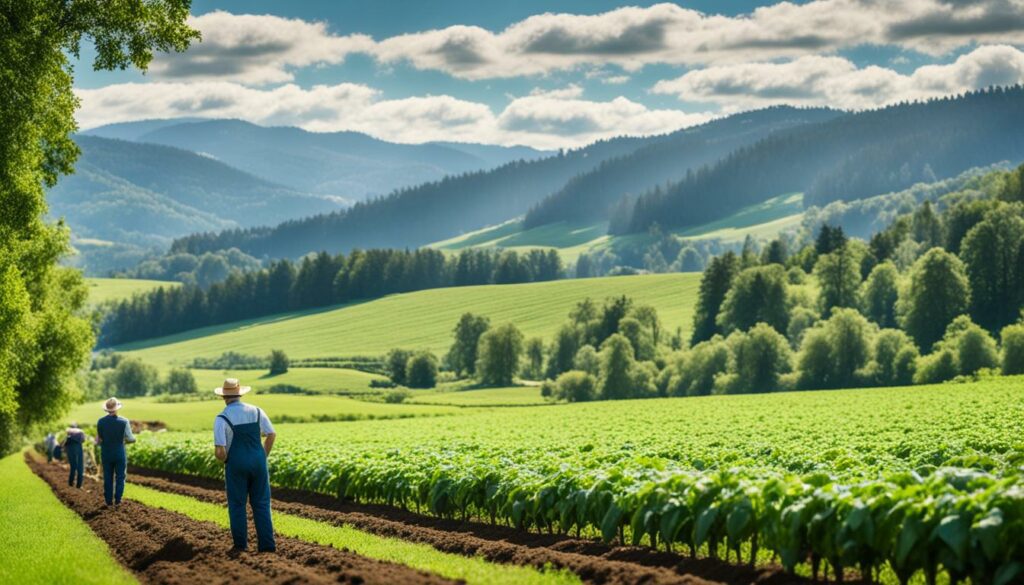
Looking at soil as a place to lock up carbon is exciting. Take Trey Hill, for example. He got $115,000 for trapping 8,000 tons of carbon in his soil. Now, if his 10,000 acres could trap just one more ton a year, he could make £150,000 yearly.
This effort isn’t just about Hill, though. If the U.S. focuses on putting away carbon in the ground, it could pull out a quarter of a billion tons each year. This amount would be equal to about 5% of all the CO2 the U.S. releases annually. And if the whole world does it, we could do away with almost 10% of the carbon cuts needed to keep temperatures from rising dangerously high.
Here’s how we can make the most of farms as carbon sinks:
| Metric | U.S. Potential Impact | Global Potential Impact |
|---|---|---|
| Soil Sequestration | 250 million metric tons CO2 annually | Approximately 10% of required global carbon reductions |
| Cover Cropping Increase | 50% (2012 to 2017) | N/A |
| Non-tillage Adoption | Over one-third of U.S. cropland | N/A |
Using all these methods can make farms a major force against climate change. It shows that farming is critical to a green future.
Moving to carbon-neutral farming face economic challenges and tech limits. To get there, we need to face high starting costs. We also must make everyone aware of ways to farm eco-friendly, which takes a lot of money and time.
Farmers need to spend a lot at the start on things like green energy or modern watering systems. The payback time on these investments is usually from 0.5 to 5 years. However, not all farmers can afford to wait that long.
Keeping up with carbon farming is also a constant investment. If farmers stop, the carbon stored in the soil could be released. So, they need good money reasons to keep at it. Proving they need financial help to do better than they would have anyway is tricky.
The tech side of farming needs to get better, especially in measuring carbon. Without good data, figuring out and trading carbon credits is hard. This holds back making a strong carbon market.
Preventing “leakage,” where different farm areas share organic material, is key. This sharing can mess up efforts to save carbon. Also, farmers must find a way to reduce the use of things like glyphosate when following carbon farming practices.
Experts predict big losses in production because of climate change. This could affect 1.5 billion people. So, it’s really important to use tech and new ideas to reduce these issues and support farming without harming the Earth.
Solving these economic and tech challenges is vital for the success of carbon-neutral farming. With continuous help and fresh ideas, we can get more farms to be truly eco-friendly. Then, we will see a real difference in how we farm our lands.
Dealing with the climate crisis in agriculture needs strong policy and regulation. Governments set goals for cutting emissions and offer money incentives for going green. In the U.S., the Growing Climate Solutions Act now helps farmers join carbon markets, a big change made in December 2022.
Regulation in sustainable farming isn’t only in the U.S. In November 2022, the European Commission put forward an idea. It’s about certifying the use of farm methods that take carbon out of the air. The idea checks if the farming method is truly good for the planet. This includes looking at the how much good the method does, if it’s really adding something new, if it’s storing carbon for a long time, and if it will keep the planet healthy.
The Natural Resource Conservation Service (NRCS) has some good news too. They found 35 ways of farming that make the soil healthier and grab carbon from the air. This adds to the rules for agriculture policy. In Spain, there’s a big project starting that aims to use farming to hold carbon. This is in 3,000 hectares of land in places like Catalonia and Aragón, showing how rules can help the earth globally.
While the European plan didn’t detail how to pay for carbon farming, it’s making a team to figure it out soon. This team, starting work in early 2023, will look into finding fair ways to check and pay for good farming. If rules clearly say how to measure, report, and check farming, everyone can work together for a greener farming future. This way, agriculture can keep up with the planet’s need for a sustainable tomorrow.
Carbon-neutral farming aims to have no extra carbon in the atmosphere. It does this by matching carbon outputs with carbon removal. Techniques include no-till farming and using renewable energy.
This type of farming is crucial for creating food in a way that doesn’t harm the planet. It helps lower harmful gases that come from farming and turns farms into places that help our environment.
Farming is a big part of why our world’s getting warmer, making up a big part of bad gases. Normal ways of farming lead to cutting trees and harming the earth, which makes things worse.
Some ways are using fewer chemicals, only using water when needed, and planting lots of different crops. These ways cut down on bad gases and help more kinds of plants and animals live.
This type of farming makes more food, keeps the ground from washing away, helps the economy grow, and makes us stronger against tough times. Everyone from farmers to shoppers wins.
Big things are rotating crops, using cover crops, not tilling the soil, and being careful with waste. Also, using the sun and wind for power helps.
Soil is great at catching carbon and keeping it out of the air. Planting different things and taking care of the soil stops it from going bad and helps plants grow more.
Agroforestry puts trees with crops, making farms better for nature and our weather. It’s a way of farming that makes trees and growing food help each other.
New tech like sensors and flying robots make farming really careful. By only using the things we need on plants, we cut down on hurting the planet.
Farms can use the sun and wind for power, instead of making the air dirty. Special machines can also turn farm waste into energy without harm.
Not using fake stuff in farming saves the world from extra bad gases. It also makes the soil rich and full of different living things, which is good for food.
Swapping crops and growing plants to protect soil are good ideas. They help the land stay healthy, make food better, and keep the Earth cooler.
Changing what animals eat and where they live makes their gases less harmful. Smart poop management also helps lower the farm’s bad effects.
We need to farm smarter, use high-tech more, and get our energy from the sun and wind. All these things together make sure we get more food without wrecking our planet.
Farms can be places that don’t add bad gas to the air and even take it away. Doing things like letting plants help each other and making sure animals don’t make too much gas is a start.
Starting to farm in a really good way costs a lot and needs people to know about these new ways. We also need special things to check we’re really helping the Earth.
Laws and rules help set goals for less bad gas, pay farmers who do good, and make sure we can trust what farmers say they’re doing. This all helps everyone use the best farming ways.